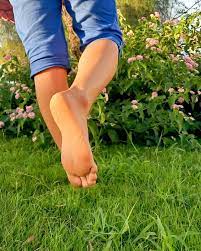 To prepare for this Earth Day column, I carried my low-to-the-ground beach chair out to the yard and set it close enough to the bird feeder to commune with my feathered friends without being pooped upon. I kicked off my flip-flops and slid my bare feet into the already-lush April grass. Then I opened my well-worn copy of “The Selected Short Stories of Eudora Welty” to page 547 and, as the late-afternoon sun descended over City Lake, began to read.
To prepare for this Earth Day column, I carried my low-to-the-ground beach chair out to the yard and set it close enough to the bird feeder to commune with my feathered friends without being pooped upon. I kicked off my flip-flops and slid my bare feet into the already-lush April grass. Then I opened my well-worn copy of “The Selected Short Stories of Eudora Welty” to page 547 and, as the late-afternoon sun descended over City Lake, began to read.
I was earthing, and it felt wonderful.
As it turns out, I’ve been doing such a thing all my life, though for the first sixty-some years I didn’t call it by name. In simple terms, earthing means putting bare skin—in most cases bare feet, because they’re easiest—on the ground. Ground can mean grass, weeds, dirt, sand, leaves, rocks, trees and other plants or even natural bodies of water. Asphalt, concrete and swimming pools don’t count.
Earthing, also called grounding, is officially defined as the practice of connecting uncovered parts of the body with the earth so that its natural negative electric charge can flow into you. According to some proponents, the ground’s free electrons neutralize the human body’s free radicals and eliminate static electrical charge. (Confession: the preceding two sentences came almost word-for-word from the internet and—not being a scientist–I have no idea what this electrical talk means. But it sounds impressive.)
Fans of earthing claim it offers important psychological benefits, including alleviating anxiety and depression. It also offers physical benefits, including but not limited to increased energy, improved sleep, reduced blood pressure, protection against viruses and even lowered cancer risk.
Earthing is closely related to the Japanese idea of shinrin-yoku, or forest bathing. In the 1980s, in response to burn-out caused by technology overload and crowded city living, officials in Japan urged citizens to head to the woods. They pointed out what wise persons throughout history have known: time spent in nature is good for us. American naturalist and philosopher Henry David Thoreau perhaps said it best when, in the 17th century, he wrote, “Heaven is under our feet as well as over our heads.”
As part of a gaggle of free-range kids growing up in the 1960s, my friends and I embraced the outdoors instinctively. We made mud pies. Built forts in the woods. Hunted tadpoles in the creek. Climbed the ancient oak tree in Mr. Wilder’s back yard and jumped into the pile of pine straw he had raked underneath it for just that purpose. Lay flat on our backs in the grass on summer evenings and watched the stars pop out. We were earthing without even knowing it. And we’re stronger and happier adults, I believe, for having grown up that way.
Earthing has some downsides, of course. Experts recommend a minimum of half an hour per day to receive maximum benefits and that’s not always possible. In the dead of winter, it’s downright unpleasant—and sometimes dangerous–to go outside with bare feet. In the warm months, ticks and mosquitos make it smarter to cover bare skin than expose it. And anyone who’s encountered a copperhead while walking barefoot through the woods has almost certainly wished to be wearing tall boots instead.
My earthing plan is uncomplicated. When the weather’s nice, I take a book and go out to the yard and sit barefoot in my folding chair for however long I want. I’ve decided, however, that if I really want to recharge, I ought to read something other than Miss Eudora’s short stories. The one I just finished is entitled “Where Is the Voice Coming From?” It’s a thinly-disguised fictional account of the 1963 assassination of civil rights activist Medgar Evers in Mississippi, told from the point of view of the murderer. Important reading, but definitely not relaxing.
At any rate, Happy Earth Day to all my readers. May you celebrate it outside with your shoes off.
(April 22, 2023)